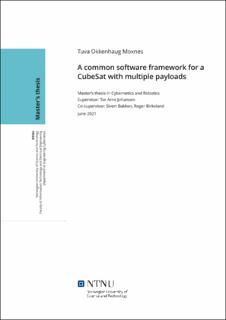| dc.contributor.advisor | Johansen, Tor Arne | |
| dc.contributor.advisor | Bakken, Sivert | |
| dc.contributor.advisor | Birkeland, Roger | |
| dc.contributor.author | Moxnes, Tuva Okkenhaug | |
| dc.date.accessioned | 2021-11-09T18:19:56Z | |
| dc.date.available | 2021-11-09T18:19:56Z | |
| dc.date.issued | 2021 | |
| dc.identifier | no.ntnu:inspera:76427839:45141812 | |
| dc.identifier.uri | https://hdl.handle.net/11250/2828757 | |
| dc.description.abstract | Overvåking av verdenshavene er nødvendig for å øke vår kunnskap om effekten av klimaendringene. Et tverrfaglig team jobber sammen på SmallSatLab ved Norges teknisk-naturvitenskapelige univer- sitet (NTNU). Teamet har som mål å designe og utvikle en hyperspektral nyttelast for en CubeSat kalt HYPSO. Nyttelasten vil bli integrert i en satelitt-bus utviklet av NanoAvionics. Satelitten er planlagt å være klar for oppskyting i fjerde kvartal 2021. Det er planlagt ett etterfølgende trinn med oppskytning av HYPSO-2. Denne nye satelitten vil ha med seg en nyttelast i tillegg, ”Software Defined Radio (SDR)”.
Målet med denne masteroppgaven er å demonstrere hvordan en kan videreutvikle en program- vareplattform til å få en fleksible arkitektur som kan støtte flere ulike nyttelaster. Integrasjon av SDRen inn i kodebiblioteket allerede utviklet for den hyperspektrale nyttelasten er brukt som eksempel. Design av programvarearkitekturen har vært avgjørende for utviklingen, og fleksible (agile) utviklingmetoder har blitt undersøkt og brukt. Modularisering, omstrukturering og gener- alisering har vært nøkkelprinsipper benyttet for å oppnå det ønskede resultat. Dette har resultert i en ny programvarearkitektur som med små endringer vil kunne støtte enhver nyttelast. | |
| dc.description.abstract | Observation of the ocean is motivated by the need of an increased understanding of climate change effects. A multidisciplinary team is working together at the SmallSatLab at the Norwegian Uni- versity of Science and Technology (NTNU) with a common goal of designing and developing a hyperspectral payload for a CubeSat called HYPSO. This payload will be integrated in a satellite bus developed by NanoAvionics, and the satellite is planned to be ready for launch in the fourth quarter of 2021. A second mission is planned to follow after this, launching HYPSO-2. This satellite will feature a second payload, the Software Defined Radio (SDR).
The goal of this master’s thesis is to demonstrate how to further develop a software platform to have a flexible architecture which can support multiple payloads. The integration of a second payload, the SDR, into the code repository already working for the hyperspectral payload, is used as an example. The design of the software architecture has been crucial for the resulting development, and agile development methods have been investigated and used. Modularization, refactoring and generalization have been the key principles used to obtain the desired result. This has resulted in a new software architecture, which with slight modifications, can support any payload. | |
| dc.language | eng | |
| dc.publisher | NTNU | |
| dc.title | A common software framework for a CubeSat with multiple payloads | |
| dc.type | Master thesis | |
